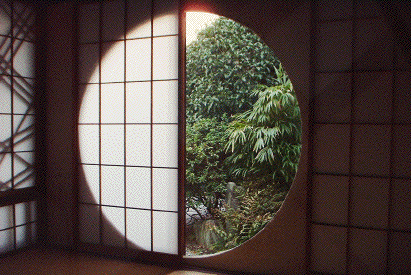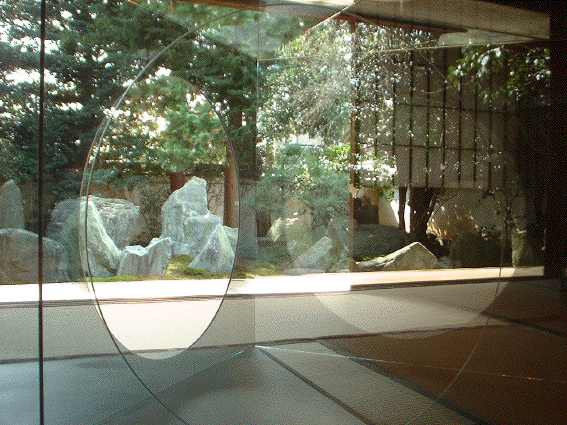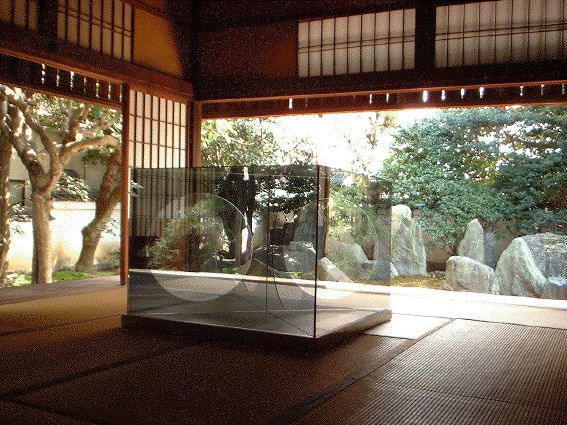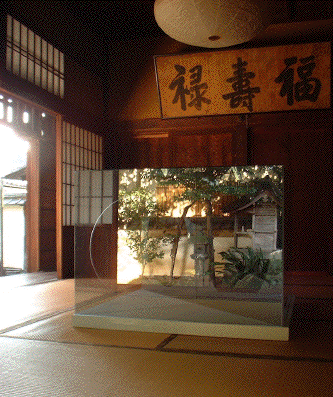

23rd - 31st March 2001
Shigemori Residence, Kyoto

Installation view click



Reflective Glass Moon Windows For more installation views click
Dan Graham's project for Shima is a variation of his model 'Pavilion Influenced by Moon Windows'. The model evokes both the historical precedent of the garden pavilion within Western architecture, from the Rococo to the 19th Century, and the circular portals of the Chinese garden with its cosmological significations of moon and earth.
Graham's model will be placed just above tatami level on the threshold of the main room (1789), where like the garden it will be viewed from a seated position. The size of Graham's structure reinforces the principles of miniaturisation employed in the garden and mirrors its relativisation of scale. Depending on the light, the model's two-way mirror walls reflect the garden and the room in myriad images, playing with the spatial unity between the garden and adjoining interior.
In framing images of the garden, the moon windows recall the way in which Chinese garden pavilions employed circular openings - analogous to the iris of the eye - to frame a view of the next walled section of the garden beyond. The four moon windows in Graham's work also echo the moon gate designed by Mirei Shigemori for his study - itself a homage to the Chinese origin of the Japanese garden.
Through the fluctuating reflections on their two-way mirror glass, Dan Graham's pavilions and models function as complex instruments of perception revealing to viewers their own bodies and themselves as perceiving subjects. Japanese temple gardens, on which the Shigemori garden is based, are loci of philosophical contemplation and meditation. Yet, whereas Buddhist meditation aims towards freeing the mind of conceptualising and towards becoming one with nature, Graham's structures confront the spectator with his/her condition in the modern world of the contemporary city with its corporate office buildings composed of semi-reflective glass.
The dual phenomena of spectatorship and spectacle that characterise contemporary urban social experience are here superimposed onto a Japanese garden, which perhaps holds the memory of a state of being before the fracturing and de-centering of the modern subject.
Karina Daskalov (art historian, curator) Mitsuaki Shigemori (artist, shima co-curator)
24th March 2001 6.30 pm - 8 pm Villa Kujoyama
17-22 Ebisudanicho Hinooka Yamashinaku Kyoto
Tel. +81 (0)75 752 7171The intention of the seminar is to consider some of the many implications raised by the Japanese landscape garden as architecture and microcosmos. The seminar considers 'Shima' as a series of parallel investigations, focusing particularly on the contribution of Dan Graham. Potential subjects for discussion include: artificial nature (the garden as artifice and model), micro/macro (the garden as microcosmos), framing and framelessness and in-betweeness (between garden and architecture, inside and outside space).
Mirei Shigemori Residence
34 Kamiojicho, Yoshida Sakyoku, Kyoto 606-8312, Japan
Fax +81 (0)75 761 8776 E-mail shima753@hotmail.com
Due to limited access by appointment onlywith the kind support of Asahi Glass Kinki Kenzai Co., Marian Goodman Gallery,
Institut Franco-Japonais du Kansai, Japan Arts Fund, Kyouei Co., Keiko Shimada and Shiseido
home | site | project | seminar | association | map | contact |